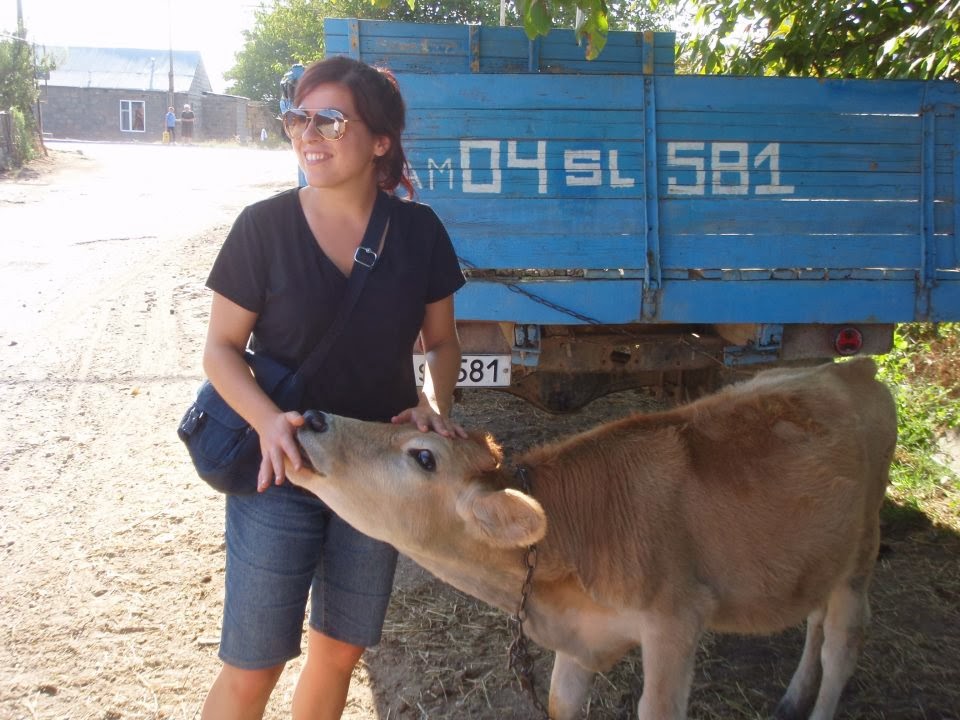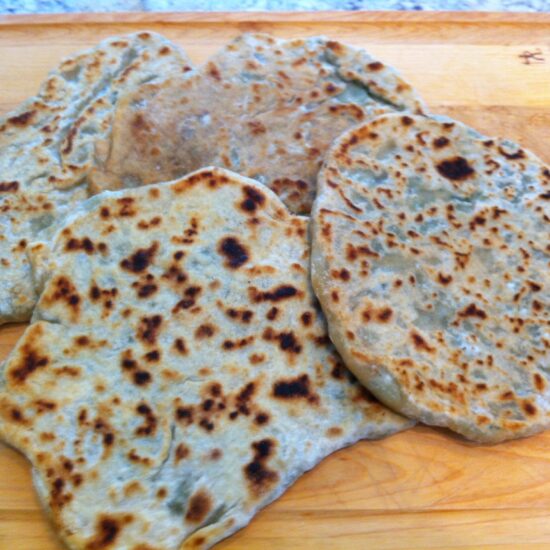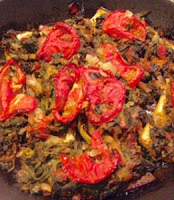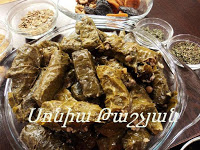The Armenian Weekly recently ran an article written by (and about) Canadian Lena Tachdjian, a Certified Nutritional Practitioner (C.N.P.) who arrived in Armenia in 2011 as a strict vegan. At first Lena found it difficult to keep her veganism in check. To help sustain herself, she carried around vegan protein bars, which according to her ‘tasted like Play-doh’, and a suitcase filled with nutritional supplements.
 |
| Lena Tachdjian and friend! |
As part of her nutritional journey, Lena created her own
travel and nutrition blog, The Traveling Chamelian – Adapting without Compromising.
Good fortune introduced Lena to “the most wonderful vegan
dish” she has ever eaten anywhere – Basoots Dolma (or BasutshTolma, according to my buddy Ara who just returned from Armenia).
dish” she has ever eaten anywhere – Basoots Dolma (or BasutshTolma, according to my buddy Ara who just returned from Armenia).
According to Lena, this dolma is “served in a pickled
cabbage leaf and contains lentils, chickpeas, red kidney beans, and grains
(spelt or bulgur), mixed with spices. It is served cold and sometimes with
dried apricot.” She continues that “it is a vegan’s dream come true – a
complete protein packed with iron and B-12 (from the pickled cabbage), and is
delicious.”
cabbage leaf and contains lentils, chickpeas, red kidney beans, and grains
(spelt or bulgur), mixed with spices. It is served cold and sometimes with
dried apricot.” She continues that “it is a vegan’s dream come true – a
complete protein packed with iron and B-12 (from the pickled cabbage), and is
delicious.”
Intrigued by the idea of this dish, I emailed Lena asking
for the recipe.
She responded swiftly with an English translation of it, noting
some important points:
for the recipe.
She responded swiftly with an English translation of it, noting
some important points:
“I have roughly translated it (into English)! Everything
seems correct except for the cabbage part. The basoots dolma I know has pickled
cabbage that’s cooked after pickling, and that is the traditional
way, but in this recipe the cooked cabbage is not pickled. I will ask
around and see if I can get the pickled recipe, but for now this is the recipe
translated.”
seems correct except for the cabbage part. The basoots dolma I know has pickled
cabbage that’s cooked after pickling, and that is the traditional
way, but in this recipe the cooked cabbage is not pickled. I will ask
around and see if I can get the pickled recipe, but for now this is the recipe
translated.”
Pickled cabbage update:
As for the cabbage, Lena’s friend said this:
“You add the cabbage leaves to 40-50 gram (about 2 ½
to 3 Tbsp.) of salt to 1 liter (approx. 4 cups) of water for about 2 weeks. If
you want it to take less days, you can put the leaves in boiling water for a
few seconds just before you put it in salt.”
to 3 Tbsp.) of salt to 1 liter (approx. 4 cups) of water for about 2 weeks. If
you want it to take less days, you can put the leaves in boiling water for a
few seconds just before you put it in salt.”
Basoots Dolma
Ingredients:
700 grams (approx. 3 cups) of olive oil
-1 kg (2.2 lbs. or about 4 cups) onion, chopped
-0.5 kg (about 2 cups) dried red beans, precooked
-0.5 kg (about 2 cups) dried peas, precooked
-0.5 kg (about 2 cups) dried chickpeas, precooked
-0.5 kg (about 2 cups) lentils (uncooked)
-300-400 gram (about 12 oz. or 1 ½ cups) grains (spelt or
cracked wheat, aka bulgur)
cracked wheat, aka bulgur)
-250 g (about 1 ¼ cups) rice (uncooked)
-2 tablespoons salt
1 TBSP. red pepper
(paprika, or perhaps Aleppo red pepper – definitely NOT cayenne!)
(paprika, or perhaps Aleppo red pepper – definitely NOT cayenne!)
black pepper (how
much you prefer)
much you prefer)
4 TBSP tomato
paste
paste
dried tsitron and basil (however much you like), cilantro
(however much you like), parsley (however much you like)
(however much you like), parsley (however much you like)
 |
| Tsitron Herb |
NOTE: Tsitron is also known as
‘kondar’ or, in English, ‘savory’
(Fresh or dried savory might not be readily available in
all locations. Ground savory is generally available in the spice section of
grocery stores.)
all locations. Ground savory is generally available in the spice section of
grocery stores.)
1 large head of cabbage
Robyn’s note: My
thought is that one can use canned red beans, such as kidney beans, and canned
chick peas to speed things up, although this might be frowned upon in Armenia!)
thought is that one can use canned red beans, such as kidney beans, and canned
chick peas to speed things up, although this might be frowned upon in Armenia!)
How to prepare:
The filling:
In the olive oil, add the chopped up onions and place it
on the stove to cook. When the onions become golden, add 1 TBSP. red pepper
(paprika or Aleppo red pepper), the dried tsitron (if available) and very
little basil, and leave them to cook together, at least for 5 minutes.
After
that, add 4 TBSP tomato paste, and wait a couple of minutes, so that it will
cook. Then add the cooked red beans, the peas, the chickpeas, and the lentils (not
cooked/boiled), the grains and the rice.
Mix all of this very well together,
and then add 1 TBSP. salt, chopped cilantro and parsley. Again, mix it well,
cover the pot and leave it for about 30 minutes.
on the stove to cook. When the onions become golden, add 1 TBSP. red pepper
(paprika or Aleppo red pepper), the dried tsitron (if available) and very
little basil, and leave them to cook together, at least for 5 minutes.
After
that, add 4 TBSP tomato paste, and wait a couple of minutes, so that it will
cook. Then add the cooked red beans, the peas, the chickpeas, and the lentils (not
cooked/boiled), the grains and the rice.
Mix all of this very well together,
and then add 1 TBSP. salt, chopped cilantro and parsley. Again, mix it well,
cover the pot and leave it for about 30 minutes.
The Cabbage: (the un-pickled
version)
version)
Add 6 cups of water to another pot, and add 1 TBSP. of
salt. At that time, get the large head of cabbage, and remove the leaves from
the stem. When the water begins to boil, add the leaves into the boiling water.
When the leaves of the cabbage become softer/tender, remove them add put them
into cold water right away. Then you can cut out the very tough areas of the
cabbage leaves, so that they will not interfere when you are wrapping the
dolma.
salt. At that time, get the large head of cabbage, and remove the leaves from
the stem. When the water begins to boil, add the leaves into the boiling water.
When the leaves of the cabbage become softer/tender, remove them add put them
into cold water right away. Then you can cut out the very tough areas of the
cabbage leaves, so that they will not interfere when you are wrapping the
dolma.
You can then open the cabbage leaves in your palm, and if
they are very large and you are having trouble, you can also place them on a
cutting board. Add about 1-2 TBSP. of the filling and wrap the dolma in a very
beautiful manner.
they are very large and you are having trouble, you can also place them on a
cutting board. Add about 1-2 TBSP. of the filling and wrap the dolma in a very
beautiful manner.
In another pot, add some cabbage leaves to the bottom,
and begin placing the wrapped dolmas on top. You can then cook it, covered, for about 30
minutes. This dish is eaten cold.
and begin placing the wrapped dolmas on top. You can then cook it, covered, for about 30
minutes. This dish is eaten cold.
(Visited 956 times, 1 visits today)





Basoots dolma is an eastern Armenian variant that throws everything in except the kitchen sink. Kind of like Mulligan's stew. Nothing exquisite about it.